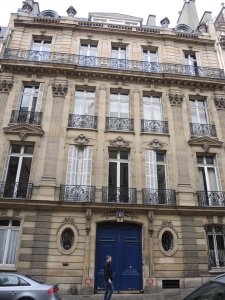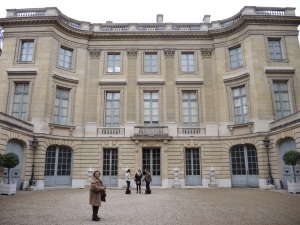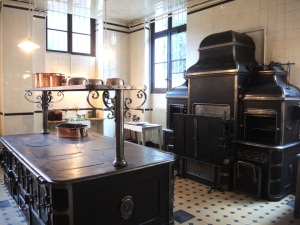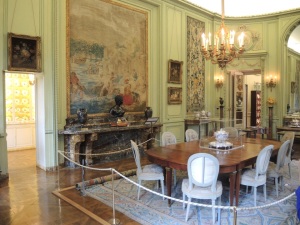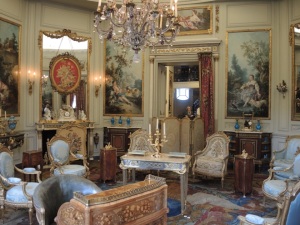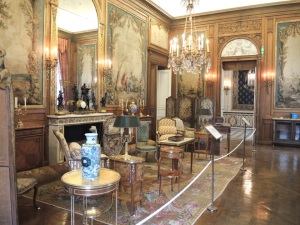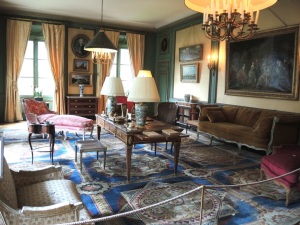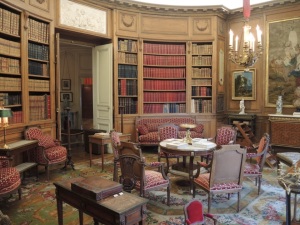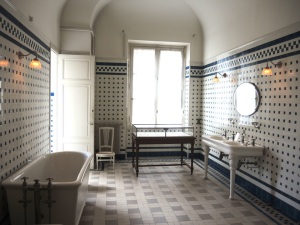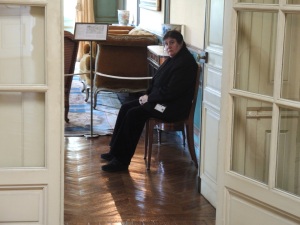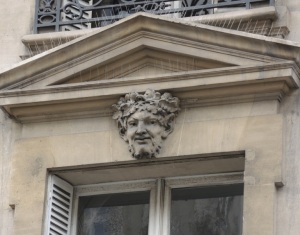
It is not the first thing you see when standing across from 81 rue Monceau, but you see it
soon enough – the two faces of the Theater of Life, the tragic and the happy, in stone, mid-way up the elegant 5-story façade. Look more closely and you’ll see that Happiness is younger, innocent perhaps, while Tragedy is older, watchful, wary.
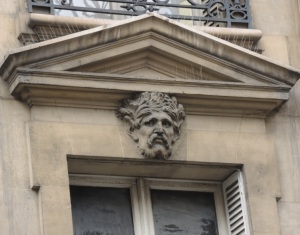
The house was the mansion of the Ephrussi family. Like the Rothschilds and other fabulously wealthy Jewish families, they had equally wealthy powerful brothers, cousins, uncles, and aunts, in Vienna and London from the end of the 1800’s up to World War II.
Rue Monceau was central to the neighborhood of the newly wealthy Parisian Jews. Well, newly wealthy in European capitals anyway. The Ephrussi were doing very well indeed in St. Petersburg and Odessa from where they had a virtual monopoly on Russian grain trade.
The Camondo family, in an even larger mansion at 63 rue Monceau, arrived massively rich as bankers from outside of Istanbul since the Ottoman Empire. Yesterday I visited this mansion, now the Musee Nissim de Camondo. (More below on that, with photos.)
And the Rothschilds had everything needed for the five sons to branch across Europe with funds from the patriarch Mayer, banker to the royal court of Free Frankfurt. The Ephrussi followed suit, establishing their own banks. Each family collected art. Charles Ephrussi, the youngest son of Leon, the first Ephrussi to come to Paris (1871), was exempt from working in banking or anywhere else that made money. It was always clear he was the arty one.
It was Charles who bought the 264 Japanese netsuke central to “The Hare with Amber Eyes,” written by Edmund De Waal, grandson of Elizabeth Ephrussi of the Vienna branch and inheritor of this exquisite collection that bizarrely survived the ravages of war and anti-Semitism. Charles was primary source-material for Charles Swann in the novels of Marcel Proust.
Charles, an eminent art historian and critic, also collected vast numbers of paintings and supported Degas, Monet, Renoir, and other Impressionists. The family benefitted from this mode of assimilation in a culture where anti-Semitism, like a virus, was biding its time. Even our favorite Impressionists could turn. Renoir, who painted Charles into “Luncheon of the Boating Party” (the man in the back in the top hat), said, given a slight grudge, that Charles collected “only Jew art,” meaning it had gold highlights in it. So much for his soft edges and round women.
The book left me emotionally bruised by anti-Semitism in a way I have not experienced in some time. I am not Jewish, but I have married and loved Jews consistently, and my daughter and grandchildren are Jewish.
What has more formed my current feelings, however, are my connections of the past 12 years in Israel and in Palestine as the founder of Peace X Peace and editor-photographer of the book “Sixty Years, Sixty Voices: Israeli and Palestinian women,” which has gone to every UN ambassador, every US Congressperson, and thousands more people working for healthy peaceful cultures.
Over time my frustration with the Israeli government and policies has grown into anger.
It is difficult not to be angry if you check your facts and believe in truth. But this book brought me back viscerally to how it feels when no matter what good you do or how wealthy or powerful you are, or how long you have been in a place, and how assimilated you feel you are that some people will continue to think of you and condemn you as a scourge, as dirty, as vile, as rapacious.
And it showed me, with the blow-by-blow devastation of the Ephrussi family in Vienna, how monsters can evade your house almost overnight and leave you only with the clothes on your back. How your treasures can be inventoried and carried away, how the only fight you have left is figuring out how to get out of your chosen nation before you, like the treasures, are shipped away.
The book is exquisite, it is terrifying. I recommend it.
Yesterday I saw the faces of Tragedy and Happiness on the face of a mansion. I think, despite the family’s assimilation, wealth, and titles, they knew their history well.
For now I will spare you my thoughts on the current effects and wounds of that history.
Just to acknowledge its truth and burden is enough for one day.
. . .
Yesterday I also spent hours inside the Musee Nissim de Camondo. This sumptuous mansion was built by Moise Camondo in 1911. When his only son Nissim died in 1917 as an aviator on World War I, Moise decided to bequest the mansion and magnificent art, furniture, silver, and china to Les Arts Decoratifs of Paris.
The photos do not show the mansion in its full magnificence as the Impressionist paintings, most well known, are in the Louvre, Musee d’Orsay, and elsewhere.
Moise died in 1935. His daughter, son-in-law, and grandchildren died in concentration camps.

